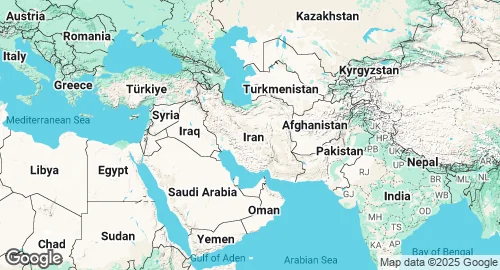Iran Military Forces 🇮🇷
Military Strength Overview
| 🛩️ Air Force | 640 active aircraft |
| ⚓️ Naval forces |
90 ships in fleet
– incl. 6 submarines |
| 🪖 Active Troops | 610,000 personnels |
| ⛑️ Reserve Troops | 350,000 personnels |
| 👮♀️ Paramilitary | 40,000 personnels |
| 🎖️ Military ranks | 150 ranks listed |
Defense Statistics & Key Metrics
| Population | 90.6 million (2023) |
| GDP | $404.6 billion (2023) |
| GDP per capita | $4466 (2023) |
| Military Budget | $7.9 billion (2024) |
| Share of GDP in Milex | 2.0% (2024) |
| Share of Govt Expenditures | 12.6% (2024) |
| Military spends per capita | $87 (2024) |
| Inflation Rate | 44.58% (2023) |
| Military Personnel | 650,000 (2020) |
Strategic Overview in 2025
Iran's military posture is defined by a unique dual-service structure, a reliance on asymmetric warfare, and a burgeoning domestic defense industry, all shaped by decades of international sanctions and regional rivalries. Its strategic doctrine prioritizes deterrence, defense of its territory, and the projection of influence through a network of regional proxies.
Military Structure and Manpower
Iran's armed forces are composed of two parallel institutions: the conventional Islamic Republic of Iran Army (Artesh) and the ideologically driven Islamic Revolutionary Guard Corps (IRGC). The Artesh is structured for traditional warfare, while the IRGC is tasked with safeguarding the revolution, operating both domestically and externally. Total active-duty personnel are estimated to be around 610,000, with a substantial reserve force of 350,000. The IRGC, with approximately 190,000 personnel, also controls the Basij, a large volunteer paramilitary force. This bifurcated structure creates both internal redundancy and potential command-and-control challenges.
Equipment and Capabilities
The Iranian arsenal is a mix of aging, pre-1979 Western systems, limited post-Soviet era Russian imports, and increasingly sophisticated indigenous products. The ground forces possess a large number of tanks and artillery pieces, though many are considered obsolete. The air force is a key vulnerability, operating a limited number of combat-capable aircraft, many of which are aging American and Soviet models. To compensate for these conventional weaknesses, Iran has invested heavily in two key areas: ballistic missiles and unmanned aerial vehicles (UAVs). Its diverse missile arsenal provides a significant strategic deterrent, while its drone program has produced a wide range of effective systems for both reconnaissance and attack roles.
The Iranian Navy operates a dual strategy. The conventional navy focuses on the Gulf of Oman and beyond, while the IRGC's naval forces are configured for asymmetric warfare in the Persian Gulf, utilizing a large fleet of small, fast attack craft.
Defense Industry and Strategic Trends
Under decades of arms embargoes, Iran has developed a significant domestic defense industry out of necessity. It now produces a range of military hardware, including tanks, naval vessels, radar systems, and its strategically important missiles and drones.
Tehran’s strategic doctrine relies on a concept of "forward defense," using proxy forces across the Middle East to counter adversaries, project power, and create strategic depth. This allows Iran to engage in regional conflicts while minimizing direct conventional military confrontations. Future trends point towards a continued emphasis on asymmetric capabilities, particularly the expansion and technological refinement of its missile and UAV programs. Iran will likely seek to modernize its conventional forces where possible, but its core strategy will remain centered on deterrence through its missile arsenal and the operational reach of its regional proxies.
Iranian Military Budget History
Population and Military Personnel Trends
GDP and Inflation Rate Trends
Iranian Aircraft Manufacturing
| Model | Manufacturer | Year | Number |
|---|---|---|---|
| Saegheh | Shahed | 2014 | 50 |
Iranian Missile Systems
| Model | Category |
|---|---|
| Shahab-3 | Ballistic |
| Shahab-1 | Ballistic |
| Shahab-2 | Ballistic |
| Qiam 1 | Ballistic |
| Fateh-110 | Ballistic |
| Fateh-313 | Ballistic |
| Raad-500 | Ballistic |
| Khorramshahr | Ballistic |
| Dezful | Ballistic |
| Sejjil | Ballistic |
| Fattah-1 | Ballistic |
| Kheibar / Khorramshahr-4 | Ballistic |
| Soumar | Ballistic |
| Ghadr-110 | Ballistic |
| Emad | Ballistic |
Iranian Firearms Development
| Model | Category |
|---|---|
| Khaybar KH2002 | Bullpup assault rifle |
Military Expenditure: SIPRI Milex.
